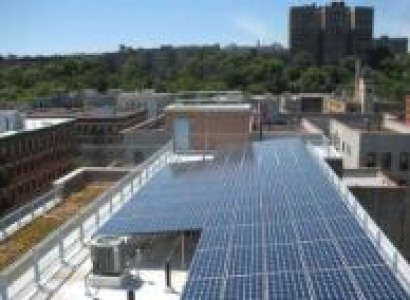
The fund is intended to support development of large-scale solar projects in New York City and in New York State’s lower Hudson Valley.
Bright Power is actively seeking building owners interested in installing solar energy systems that will earn a robust return on investment (three-year payback) and reduce their electrical energy costs for the next 25 years.
To be eligible, buildings should ideally have at least 10,000 square feet of unshaded roof, ground, or parking lot space, and annual electric bills exceeding $25,000 per year (approximately $2,000/month). Bright Power is offering free roof assessments to building owners interested in this program; financing options are available.
Bright Power was selected in January to receive funds by a competitive application process as part of NYSERDA Program Opportunity Notice 2156 (PON 2156).
The funds are part of the RPS Customer-Sited Tier Regional Program, which will offer $150 million over the course of five years to encourage large businesses -- particularly manufacturing facilities, colleges & universities, and schools -- to access incentives for renewable energy.
Of the $30 million awarded each year, $25 million is designated for New York City and Westchester County, and $5 million for the Hudson Valley region.
The program is funded under the state's Renewable Portfolio Standard (RPS). The RPS, created by the state Public Service Commission in 2004 to reduce dependence on fossil fuels, is administered by NYSERDA using a surcharge collected from ratepayers served by investor-owned utility companies.
For additional information:
Bright Power http://www.brightpower.com/2012-2-6-NYSERDA-solar No doubt CSP technology market expected to revive in 2012, compete with PV soon, report says The Concentrating Solar Power (CSP) market will begin rise again in 2012 and its growth will be steady and certain over the next five years, according to new research from SBI Energy.
Emerging from the doldrums it entered as cheap solar PV swept into the solar market, , the global capacity of utility-scale CSP was 2 GW at the close of 2011 with approximately another 2500 to 3500 MW becoming operational in 2012. SBI Energy estimates the cost of the installed base of CSP at the end of 2011 at $9.5 billion with power tower technology increasing its market share.
Four approaches to the collection and use of the sun's heat energy are currently in use in CSP plants, although parabolic trough holds 93 percent of the installed base value.
By 2015, that percentage is forecast to drop to 70 percent as power tower, also called central receiving station technology, becomes more common.
The other two CSP technologies, linear Fresnel reflector and the Stirling engine/dish design, have only a few small projects going forward. CSP processes are known by several names: Concentrating or Concentrated Solar Power, Thermal Energy Storage, and Solar Thermal Power.
"Thermal energy storage (TES) became a big topic in 2011 with demonstrations of 24 hour generation at a plant in Spain less than four months after startup," said SBI Energy analyst Jean Diener, author of Concentrating Solar Power (CSP), a global market research study. "Seven to eight hours of storage appears to be the norm for parabolic trough plants, with roughly an additional 10-11% of costs for the plant, but it can yield capacity factors over 50%, a key to profitability. Power towers operating at higher temperatures can achieve 10- 15 hours of storage at a slightly lower cost."
Further, CSP technology may be coupled with a traditional fossil-fuel plant to serve as daytime-demand power, or to decrease turbine sizing, or to meet regulatory requirements. Hybrid plants incorporate a solar energy fuel source with a more conventional one, typically natural gas as it is easy to transport to remote locations, doesn’t require the complicated material handling system of coal plants, is readily available in many places throughout the world and is cost competitive.
New development and construction activities will intensify in 2012 in Australia, India, and China, the report said.
China has licensed technology from eSolar and plans to build 2 GW of combined CSP/biomass plants in the next decade. India too has created a 20 GW by 2020 solar wish list. Australia continues to study the technology and is building a world study center of power tower technology.
While some forecasters believe that US concentrating solar power capacity alone will reach 6 GW by 2015, SBI Energy's analysis points to factors that suggest an installation rate consistent with the opportunities CSP represents, but is more indicative of current global economic and political realities.
For additional information:

